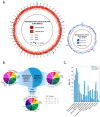Comprehensive Genome Analysis on the Novel Species Sphingomonas panacis DCY99T Reveals Insights into Iron Tolerance of Ginseng
- PMID: 32188055
- PMCID: PMC7139845
- DOI: 10.3390/ijms21062019
Comprehensive Genome Analysis on the Novel Species Sphingomonas panacis DCY99T Reveals Insights into Iron Tolerance of Ginseng
Abstract
Plant growth-promoting rhizobacteria play vital roles not only in plant growth, but also in reducing biotic/abiotic stress. Sphingomonas panacis DCY99T is isolated from soil and root of Panax ginseng with rusty root disease, characterized by raised reddish-brown root and this is seriously affects ginseng cultivation. To investigate the relationship between 159 sequenced Sphingomonas strains, pan-genome analysis was carried out, which suggested genomic diversity of the Sphingomonas genus. Comparative analysis of S. panacis DCY99T with Sphingomonas sp. LK11 revealed plant growth-promoting potential of S. panacis DCY99T through indole acetic acid production, phosphate solubilizing, and antifungal abilities. Detailed genomic analysis has shown that S. panacis DCY99T contain various heavy metals resistance genes in its genome and the plasmid. Functional analysis with Sphingomonas paucimobilis EPA505 predicted that S. panacis DCY99T possess genes for degradation of polyaromatic hydrocarbon and phenolic compounds in rusty-ginseng root. Interestingly, when primed ginseng with S. panacis DCY99T during high concentration of iron exposure, iron stress of ginseng was suppressed. In order to detect S. panacis DCY99T in soil, biomarker was designed using spt gene. This study brings new insights into the role of S. panacis DCY99T as a microbial inoculant to protect ginseng plants against rusty root disease.
Keywords: Biotic stress; Iron stress; Panax ginseng; Plant growth-promoting rhizobacteria; Sphingomonas.
Conflict of interest statement
The authors declare no conflict of interest.
Figures






Similar articles
-
Genomic Characterization of Potential Plant Growth-Promoting Features of Sphingomonas Strains Isolated from the International Space Station.Microbiol Spectr. 2022 Feb 23;10(1):e0199421. doi: 10.1128/spectrum.01994-21. Epub 2022 Jan 12. Microbiol Spectr. 2022. PMID: 35019675 Free PMC article.
-
Sphingomonas panacis sp. nov., isolated from rhizosphere of rusty ginseng.Antonie Van Leeuwenhoek. 2015 Sep;108(3):711-20. doi: 10.1007/s10482-015-0527-y. Epub 2015 Jul 9. Antonie Van Leeuwenhoek. 2015. PMID: 26155772
-
First Report of Rhexocercosporidium panacis Causing Rusty Root of Panax ginseng in Northeastern China.Plant Dis. 2014 Nov;98(11):1580. doi: 10.1094/PDIS-01-14-0082-PDN. Plant Dis. 2014. PMID: 30699804
-
Cylindrocarpon destructans/Ilyonectria radicicola-species complex: Causative agent of ginseng root-rot disease and rusty symptoms.J Ginseng Res. 2018 Jan;42(1):9-15. doi: 10.1016/j.jgr.2017.01.004. Epub 2017 Jan 16. J Ginseng Res. 2018. PMID: 29348716 Free PMC article. Review.
-
Sphingomonas: from diversity and genomics to functional role in environmental remediation and plant growth.Crit Rev Biotechnol. 2020 Mar;40(2):138-152. doi: 10.1080/07388551.2019.1709793. Epub 2020 Jan 6. Crit Rev Biotechnol. 2020. PMID: 31906737 Review.
Cited by
-
Plant growth-promoting properties of Streptomyces spp. isolates and their impact on mung bean plantlets' rhizosphere microbiome.Front Microbiol. 2022 Aug 25;13:967415. doi: 10.3389/fmicb.2022.967415. eCollection 2022. Front Microbiol. 2022. PMID: 36090067 Free PMC article.
-
Effect of tobacco-radish rotation for different years on bacterial wilt and rhizosphere microbial communities.AMB Express. 2024 Oct 17;14(1):116. doi: 10.1186/s13568-024-01760-x. AMB Express. 2024. PMID: 39419902 Free PMC article.
-
Soil Geochemical Properties Influencing the Diversity of Bacteria and Archaea in Soils of the Kitezh Lake Area, Antarctica.Biology (Basel). 2022 Dec 19;11(12):1855. doi: 10.3390/biology11121855. Biology (Basel). 2022. PMID: 36552364 Free PMC article.
-
Antioxidant, Nutritional Properties, Microbiological, and Health Safety of Juice from Organic and Conventional 'Solaris' Wine (Vitis vinifera L.) Farming.Antioxidants (Basel). 2024 Oct 9;13(10):1214. doi: 10.3390/antiox13101214. Antioxidants (Basel). 2024. PMID: 39456467 Free PMC article.
-
Genomic Characterization of Potential Plant Growth-Promoting Features of Sphingomonas Strains Isolated from the International Space Station.Microbiol Spectr. 2022 Feb 23;10(1):e0199421. doi: 10.1128/spectrum.01994-21. Epub 2022 Jan 12. Microbiol Spectr. 2022. PMID: 35019675 Free PMC article.
References
-
- Shahid M., Khalid S., Abbas G., Shahid N., Nadeem M., Sabir M., Aslam M., Dumat C. Crop Production and Global Environmental Issues. Springer; Berlin/Heidelberg, Germany: 2015. Heavy metal stress and crop productivity; pp. 1–25.
-
- Bodek I. Environmental Inorganic Chemistry: Properties, Processes, and Estimation Methods. Pergamon Press; Pergamon, Turkey: 1988.
-
- De Dorlodot S., Lutts S., Bertin P. Effects of ferrous iron toxicity on the growth and mineral composition of an interspecific rice. J. Plant Nutr. 2005;28:1–20. doi: 10.1081/PLN-200042144. - DOI
-
- Zhang Y., Wang Q., Xu C., Sun H., Wang J., Li L. Iron (Fe2+)-induced toxicity produces morphological and physiological changes in roots in Panax ginseng grown in hydroponics. Toxicol. Environ. Chem. 2016;98:630–637. doi: 10.1080/02772248.2015.1133385. - DOI
MeSH terms
Substances
Supplementary concepts
Grants and funding
LinkOut - more resources
Full Text Sources
Medical
Molecular Biology Databases

